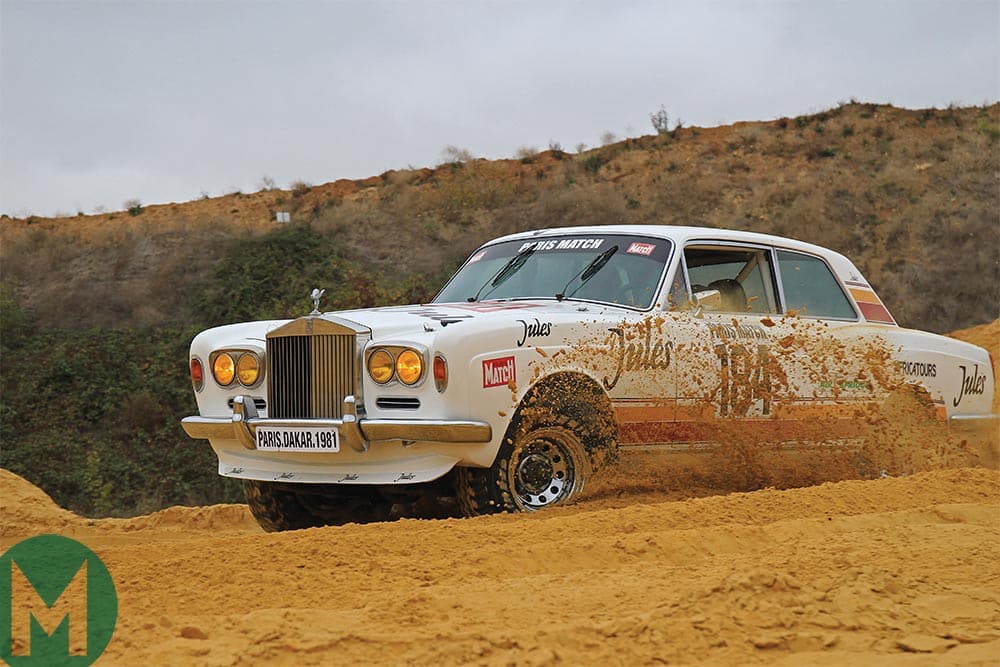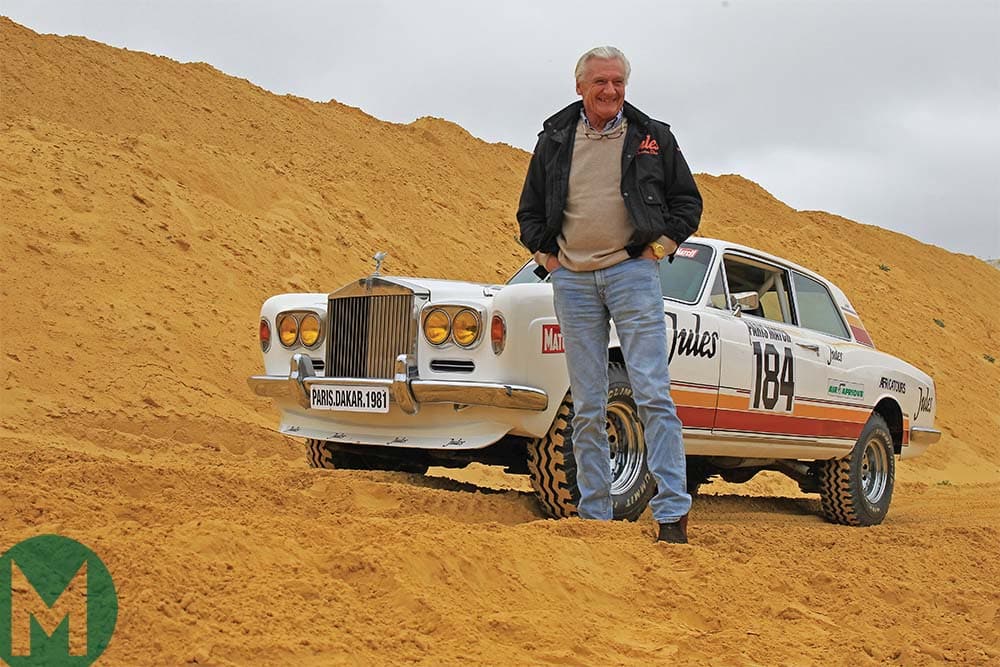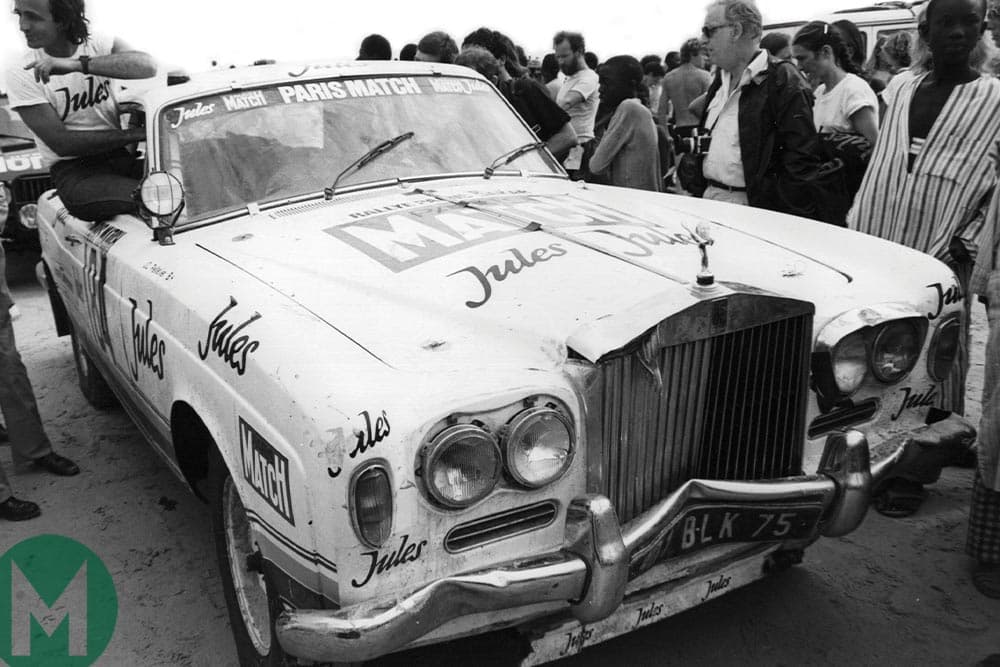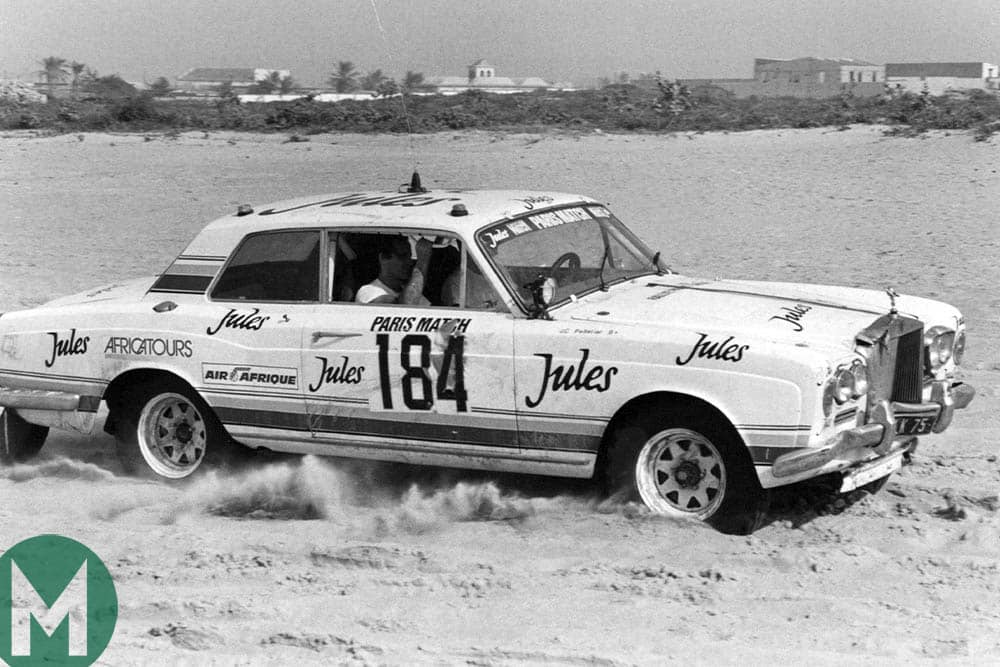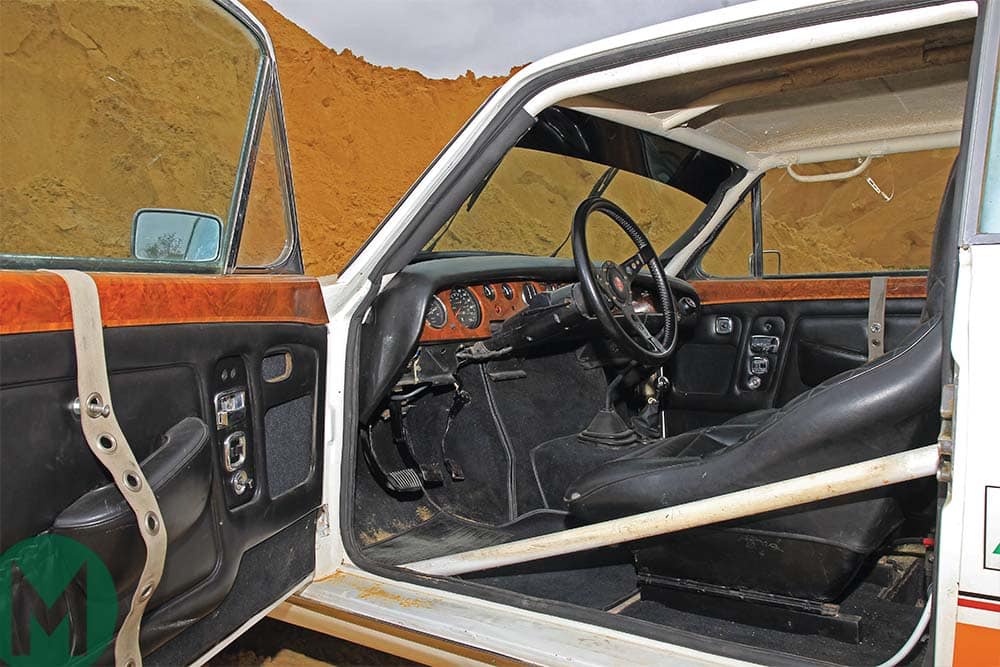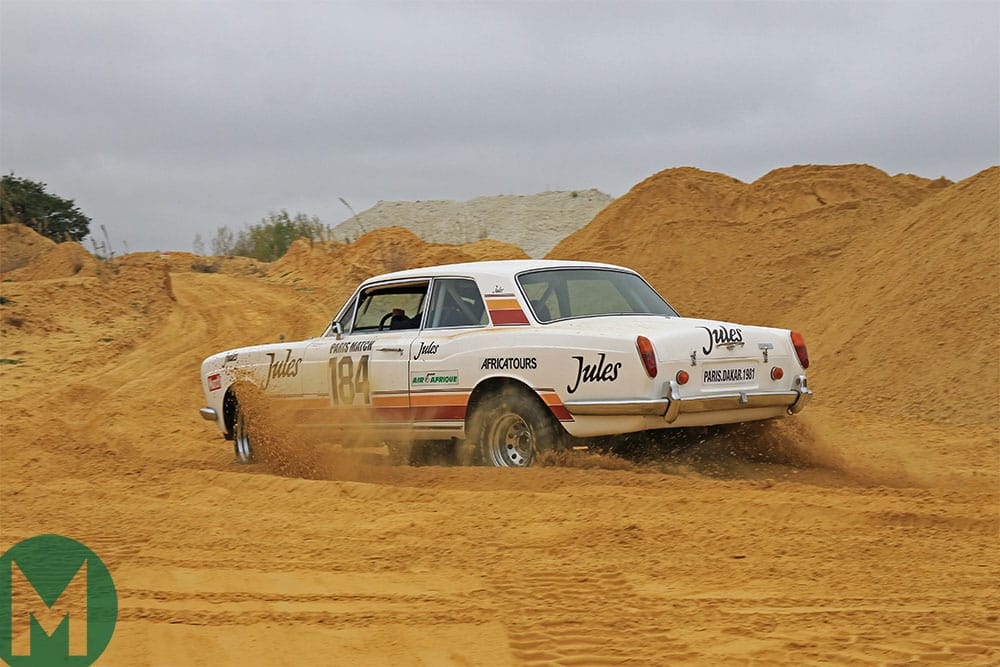Quicksand
“The oysters only lasted for three days,” says the suave Thierry de Montcorgé, who would not be out of place if thrown among a gaggle of unconventional and swashbuckling Rolls-Royce drivers, including Lawrence of Arabia, Indian Maharajahs and even the fictitious Sheikh Falafel from Cannonball Run. His claim to fame? He drove a 1970s Corniche on the 1981 Paris-Dakar Rally.
For the first few nights of the event, deep in the Sahara, de Montcorgé and his co-driver Jean-Christophe Pelletier would set up an impromptu bivouac behind their Roller. From a basket they would pull oysters and other gastronomic goodies to ease the pain of battling the world’s largest desert. All washed down with champagne, but without the benefit of a drinks cabinet. Perhaps foolishly, they had removed it during preparations for the infamous enduro.
Modern-day competitors in the self-styled world’s toughest race, which gets underway this month in South America, could be forgiven for staring in disbelief at that sentence. But they can be reassured that even in 1981 the Dakar still had teeth: soon, the rigours of the rally and the harsh desert conditions made evening tipples few and far between. “It is a very special race because it’s very long and so very, very hard,” he adds. “If everything is all right it’s OK, but if you have any problems you start having to work the night and you are more and more tired. At the end you are completely dead.”
Unsurprisingly, de Montcorgé and Pelletier were not taken seriously when they lined up with 290 others in the French capital for the third edition of the rally. Not even when previous entries had included a Citroën 2CV and a delivery van. By 1981 the rally to the Senegalese capital was attracting factory Range Rover entries and racing legends like Grand Prix and Le Mans winner Jacky Ickx. The Rolls was seen as comedic, at best.
“At the beginning everybody thought it was a joke,” admits de Montcorgé. “But at the first timed stage we were competitive and when they saw that they said, ‘Ah… maybe it’s not a joke.’ When at half-distance we were lying 13th, the view of the car had changed completely.”
IT LOOKS LIKE one and sort of sounds like one, but the Dakar Corniche is not really a Rolls. For reliability and low-down torque, the original silky smooth 6.75-litre engine was swapped for a 5.7-litre Chevy V8. To bolster strength, the chassis and transmission were replaced by a Toyota HJ45 Land Cruiser and, to save weight (it is now 1.4 tons), large amounts of the body were recast in fibreglass. The original aluminium doors and boot lid, plus famous flying lady, grille and deep veneer dashboard all remain. The rest of the car was sold off – and not with much regret, it seems.
“It was the car of my best friend, Jean-Christophe, my co-driver. And because the car was often breaking down, over lunch one day we decided to transform it, to put it in the desert,” Thierry says. But with no money to create the rallying Rolls, he went looking for sponsorship. And quickly found it at Christian Dior, which had a new aftershave called Jules. Two days after (another) lunch with the Christian Dior CEO, a cheque for half the sponsorship was in the post.
Thierry’s background was in building race buggies and he brought his old friend and wonder mechanic Michel Mokrycki to help turn the boulevard cruiser into a desert warrior. “From the day we had the cheque to the start of the rally, we had three months. We slept only three or four hours a night. The rest of the time was in the workshop,” he says.
Over lunch (food a key factor in this story), they evolved the design as it went along by scribbling on napkins. Once the donor Toyota chassis and Chevy engine had been chosen, the biggest job was the fibreglass shell. Both were experienced car builders and, looking at the car more than 30 years later, you can tell. The workmanship is simple, robust and immaculate. Thierry might have had a racing background, but it was the first competition car Michel had fabricated.
DE MONTCORGÉ invited me to a sandpit just outside Paris to drive his Corniche. It doesn’t measure so much as a mile, compared with the 6000 or more it had to endure across the Sahara. The Corniche reached Dakar, but was unclassified after a steering arm failure. Since then, with a dent removed from the front, it is now almost exactly as it was when it pulled into Dakar.
Before I am allowed behind the wheel, Thierry shows me around his old friend. He sold it a few years ago but they reunite fairly regularly. The bond is still close. His name and blood type (the Dakar is said to have claimed 70 lives since its inception 40 years ago) remain on the door, which is festooned with period sponsorship stickers.
On the outside it still looks like a Corniche, albeit one that has been on a Schwarzenegger body-building course. Inside, only the wood dash (with disconnected air-con vents) and dials are original. “We navigated using the odometer,” says Thierry, perched in one of the bucket seats. The leather benches went with the rest of the donor car. He designed it to be strong and comfortable and have huge grunt. With up to 700km a day to endure, little else mattered. One stage, en route to the oasis of Timbuktu, stands out in Thierry’s mind for the Rolls performing at its best.
“It was a big desert in southern Algeria, with a big, big, long, long road and we were at maybe 150kph. It was like [driving] on the snow and the ice or being in a little boat. It was ‘fantastique’. In my memory the sand was very white and it was so smooth – and the car was running perfectly. I keep this image in my head.”
This image now in my head, I pull the original Corniche door shut with a very un-Rolls thud. It starts with the original key but ignites a brutish V8 connected to a pair of exhaust pipes emanating from beneath the doors. This is no Roller. It’s a Rocker.
“AFTER LUNCH WITH THE CHRISTIAN DIOR CEO A CHEQUE FOR HALF OF THE SPONSORSHIP WAS IN THE POST”
Ballet shoes would be better than work boots to operate the pedals, which sit uncomfortably close to each other. Given that the brakes are next to useless and second gear seems to suit most eventualities.
The course we have is a lap up and over a pile of sand so yellow it looks to have come from a cartoon palette. It’s hard to walk on but the massive tyres chomp into the silica and propulsion is never in doubt. Thierry had told me of a day when the Rolls charged up and over 30-metre dunes that entrapped most other cars. They never got stuck. With 390lb ft of torque, I can understand why.
“I remember we had a little mountain and everybody was stuck – maybe 10 cars. We went around them, climbed the mountain and were laughing. It was so easy.”
It might have four-wheel drive, unlike its donor car, but somehow this desert brute has retained some of the Spirit of Ecstasy. I once drove a stock Phantom through the Atacama Desert and was staggered at the off-road ability of a car made to waft along the highway. It even soaked up large rocks and deep holes. Despite having had its pure British DNA compromised, the Corniche’s steering is still finger-tip light, the ride is supple and (as Rolls likes to say when questioned) it has ‘sufficient’ power.
Imagine Muhammad Ali in a tutu and this is pretty much what Thierry has built. I rarely get above 40mph but can imagine floating across the Sahara at more than 100, the sloshing of fuel and Pomerol and the fading odour of shellfish as an accompaniment.
But for the collision with a tree and vital time lost, the Rolls could have finished high on the Dakar leaderboard. Instead, it was allowed by Dakar creator Thierry Sabine to finish unclassified. Possibly because Christian Dior had laid on enough champagne (and possibly oysters) in Dakar for the whole field.
“The best memory for me was on the beach at Dakar,” former Jules PR boss Joëlle Demange says. She has come to reunite with Thierry and Michel and see the car that captivated the world in January 1981. More than 1600 articles and 150 TV reports featured the luxury desert cruiser carrying the Jules name. “Everybody – everybody was looking for the Rolls Royce – no other cars. It was the princess of the desert at that time. Everybody was waiting for the Rolls-Royce.”
DWARFED BY THE ATTENTION the Rolls received, the winner of that year’s Dakar was René Metge in a works Range Rover. “The Rolls was the star that year, it was a great idea and done seriously and professionally,” Metge says. “It really was the last endeavour of its kind, an amateur team attempting what the Dakar had started; it was fun, but with a strong sense of adventure.”
Now Rolls-Royce has made its own 4×4 SUV, the Cullinan, maybe it should look at a return to the Dakar? Joëlle recalls the then-boss of Rolls told her he had had dozens of enquiries to buy a rally Corniche. It never did make one, and having benefited from immense publicity didn’t complain too much to Thierry about use of the firm’s name for his gain.
“I received a letter from Rolls-Royce six months after the rally. It was very, very polite,” Thierry says. “Dear Monsieur de Montcorgé – you know that it’s a brand patent and you know you have no right to use it. Please in future don’t do that again.”
And he didn’t. Thierry and the Corniche only did the one Dakar. By 1982 the rally was getting seriously competitive and the days of champagne and oysters were all but gone.
“It didn’t change my life,” he says, “but I’m glad when people remember the Rolls-Royce that did the Dakar.”
